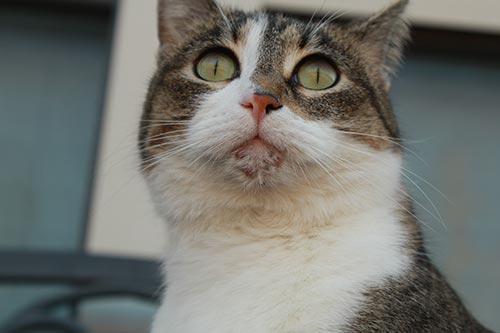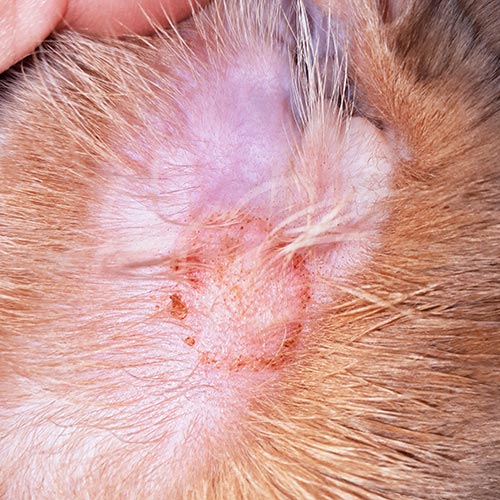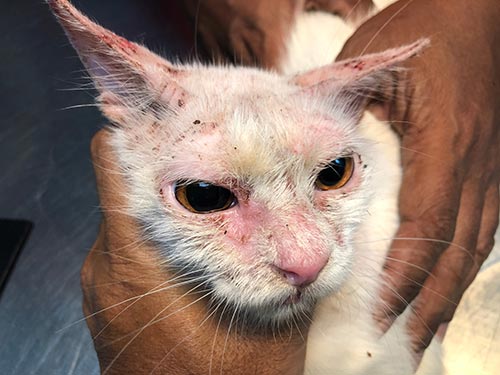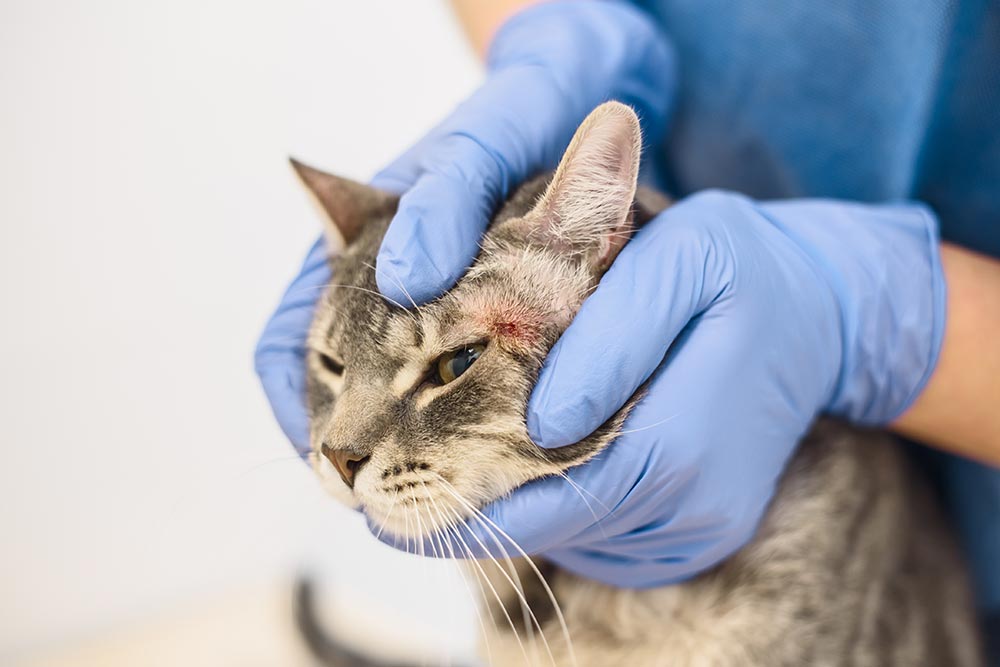A concerned client called the clinic about her cat one day because he had scabs on his chin. I told her there are various reasons for scabs on a cat, and she should bring the kitty in for an exam.
In this article, I’ll explain the top reasons your cat can develop chin scabs and each one’s appearance, diagnosis, and treatment. Then, I’ll share what you can do at home for your kitty and when to seek veterinary care. To help you prepare for the exam, I’ll tell you what to expect when you visit your veterinarian.
Most likely causes of scabs on a cat’s chin
1. Flea allergy dermatitis
Flea allergy dermatitis is one of the top causes of chin scabs on a cat, and it’s the easiest to diagnose. Usually, flea bites cause mild irritation, but some cats have an allergic reaction to their saliva. When this happens, scabs can develop on the back, head, and neck.
Appearance: multiple crusty lesions on the chin. See this picture for a good example.
Symptoms:
- Multiple, small, crusty scabs
- Generalized itching with licking, scratching, or biting
- Hair loss
- Rash with eczema
- Presence of fleas or flea dirt
Diagnosis: Diagnosis is by clinical observation of hair loss, evidence of fleas, and intradermal skin testing.
Treatment: Treatment involves eliminating the fleas on your cat and treating the environment to prevent re-infestation. Your vet may also prescribe anti-inflammatory drugs and antibiotics if needed.
Prognosis: Usually good with treatment and ongoing flea prevention
2. Other allergies
Cats may also suffer skin conditions that cause scabs from food or environmental allergies. If your kitty suddenly starts itching, and you recently changed her food, it may be an ingredient in the new formula. Otherwise, something in the environment may be the trigger.
Appearance: multiple crusty lesions and bumps similar to flea allergy dermatitis

Symptoms:
- Crusty skin
- Miliary bumps/scabs
- Non-seasonal, repeated itching
- Thinning hair
- Lesions around the head, face, neck, and ears
- Vomiting
Diagnosis: Diagnosis is based on observation of the skin lesions, ruling out flea allergy dermatitis, and food trials to rule out or confirm the cause.
Treatment: For food allergies, your vet will try a hypoallergenic diet. Treatment for environmental allergies includes trigger avoidance(if possible). Corticosteroids or antihistamines may also be prescribed to reduce inflammation and itching.
Prognosis: The prognosis is generally good with treatment if the trigger can be identified and avoided. However, allergies usually affect cats for life.
3. Feline acne
Yes, cats get acne. With feline acne, blackheads on the chin can lead to pustules, inflammation, and itching. When the pustules break open, you may see scabbing. Food allergies, plastic food bowls, infections, and other factors may cause feline acne.
Appearance: blackheads, pustules, and scabbing with a greasy crust on the chin

Symptoms:
- Cluster of blackheads
- Pustules
- Greasy appearance
- Inflammation
- Crusty scabs
Diagnosis: Your vet will diagnose acne based on your cat’s history, observation of signs, and elimination of other conditions. He may take a skin-scraping to confirm the diagnosis.
Treatment: Clean the chin twice a day using witch hazel. Feed your cat using glass or stainless steel bowls. Your veterinarian may prescribe topical or oral antibiotics if the area is infected.
Prognosis: Good with treatment
4. Ringworm
Ringworm is an infectious fungal disease that leaves lesions and scabbing anywhere on your cat’s body including the chin.
Appearance: circular rash with redness/inflammation. Note: the picture below is a lesion on a cat’s ear but is typical of the ringworm lesion.

Symptoms: circular reddened lesion with hair loss, scaly skin, and scabbing
Diagnosis: in addition to clinical observations, your vet may examine hairs from the edge of the lesion to look for fungal cells or look at the lesion under a fluorescent light.
Treatment:
- Wash all bedding in hot water and sundry it
- Clean surfaces with 10% bleach solution
- Clip the hair back from the lesions and treat them with a medicated shampoo
- Your veterinarian will prescribe topical creams or sprays
Prognosis: Good with treatment
5. Mange
Mange is an infectious disease caused by tiny skin parasites called mites. As they burrow in the skin, they cause inflammation and extreme itching.
Appearance: crusty, red skin with scabs and patches of hair loss

Symptoms:
- Patchy hair loss
- Skin crusting/scabbing
- Areas of red skin and sores
- Extreme itching
Diagnosis: Your veterinarian will obtain a skin scraping or an acetate tape impression and examine it under a microscope for evidence of mites.
Treatment: Depending on the type of mite affecting your cat, treatment may include topical, oral, or injectable medications to eliminate the mites. If a secondary infection is present, he will also prescribe antibiotics.
Prognosis: It may take several days, but the prognosis for recovery is good with treatment.
Is there anything I can do at home to help my cat?
When you find chin scabs on your help, some things you can do at home to help your cat include:
- Check your kitty for signs of bug bites, mites, or fleas, and eliminate any pests
- Treat the environment to remove parasite eggs
- Use an e-collar to prevent scratching and injuring the skin
- Consult with your vet about applying topical ointments or steroid creams to the lesions
- Try an elimination diet if you suspect food sensitivities
- Prepare a dry oatmeal shampoo by baking oatmeal at 250 degrees for 5 minutes and allowing it to cool. Then, massage it into your cat’s coat and brush or wipe it out.
Can cat chin scabs resolve on their own over time?
When scabs are caused by reactions to parasites, the environment, or food, they may resolve after you address and eliminate the triggers. Try giving your kitty a flea treatment or changing his diet. Additionally, you should strive to reduce stress in your feline’s environment. If you don’t see improvement in a few days, contact your veterinarian.
When to seek veterinary treatment for scabs on a cat’s chin
It’s best to check with your veterinarian as soon as you see scabs on your cat’s chin. Leaving the lesions untreated can lead to infection. If you try home remedies and don’t see improvement in 1-2 days, schedule an exam for your kitty.
Additionally, contact your vet if:
- The scabs are Bleeding
- The scabs are infected or pussy
- Your cat won’t eat
- Your cat has vomiting/diarrhea
- Your cat is restless or irritable
How do vets diagnose chin acne in cats?
A preliminary diagnosis is possible based on your cat’s history and signs. Once your veterinarian examines your furbaby, the doctor may take blood and urine samples and skin cultures or scrapings to confirm his findings. If the lesions aren’t typical, he may also take a biopsy to rule out cancer or other causes.
What to expect at the vet
When you take your cat to the vet, the doctor will ask you questions about any recent changes in your cat’s behavior, diet, or environment. Then, he will conduct a complete physical examination and pay special attention to the affected areas.
Based on his initial findings, your veterinarian may run diagnostic tests such as:
- Blood tests
- Urinalysis
- Skin scrapings
- Hair samples from the edges of the lesion
- Acetate impression of the skin
- Intradermal skin tests
If your cat’s scabs are tied to allergies, you may need to schedule a series of clinical appointments to identify the triggering allergen.
Frequently asked questions
Will my cat’s chin scabs appear again?
Once your cat receives appropriate treatment and the chin scabs resolve, you need to focus on prevention. Most causes of chin scabs can reoccur. Depending on the condition that triggered chin scabs, you can:
- Feed your dog a hypoallergenic diet
- Use antiparasitic drugs regularly to prevent fleas, mites, or other skin parasites
- Clean your kitty’s chin with witch hazel or an approved medicated shampoo
- Apply coconut oil to the skin to soothe itching and reduce inflammation
Are my cat’s scabs contagious to other cats?
If your cat’s scabs are caused by mange or ringworm, they are contagious to other cats. Isolate your kitty from other felines during treatment as directed by your veterinarian.
Can I put coconut oil on my cat’s scabs?
Coconut oil is safe to use on your cat. Additionally, the plant-based oil offers many benefits, including anti-inflammatory effects, promotion of wound healing, and skin barrier protection.
How can I make my cat’s scabs heal faster?
Some ways to promote faster healing of your cat’s scabs include:
- Use an e-collar to prevent scratching
- Apply a topical cream or steroid to reduce inflammation
- Apply virgin coconut oil topically to promote healing

